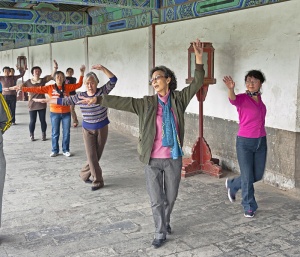Physical Activity in Ageing and Falls: Difference between revisions
Wendy Walker (talk | contribs) No edit summary |
Wendy Walker (talk | contribs) (Undo revision 175257 by Wendy Walker (talk)) |
||
| Line 25: | Line 25: | ||
*and [[Stroke|page in Physiopedia related to the above example document]] | *and [[Stroke|page in Physiopedia related to the above example document]] | ||
</div> <div class="editorbox"> | </div> <div class="editorbox"> | ||
'''Original Editor '''- Caroline | '''Original Editor '''- Caroline Hooper | ||
'''Top Contributors''' - {{Special:Contributors/{{FULLPAGENAME}}}} | '''Top Contributors''' - {{Special:Contributors/{{FULLPAGENAME}}}} | ||
Revision as of 03:21, 13 June 2017
- Please do not edit unless you are involved in this project, but please come back in the near future to check out new information!!
- If you would like to get involved in this project and earn accreditation for your contributions, please get in touch!
Tips for writing this page:
Please consider including the following topics in this page plus other subjects that you think are appropriate:
- x
- x
A quick word on content:
When you write this page please include:
- Evidence (where appropriate and available
- References
- Images and videos
- A list of open online resources that we can link to
- Links to other pages in this project
Example content:
Original Editor - Caroline Hooper
Top Contributors - Wendy Walker, Vidya Acharya, Kim Jackson, Lauren Lopez, Lucinda hampton, Rucha Gadgil, Michelle Lee, Rishika Babburu and Giulia Neculaes
What is Ageing?[edit | edit source]
Benefits of Exercise[edit | edit source]
What Exercise is appropriate for Older Adults?[edit | edit source]
Clinical guidelines[edit | edit source]
The current international recommendations for adults for physical activity include:
- Australia Everyone should try to do at least 30 minutes of moderate intensity physical activity on most days of the week[1].
- Canada Put together at least 30 minutes of moderate-intensity physical activity on most preferably all days[2].
- America All adults should accumulate a minimum of 30 minutes of at least moderate intensity physical activity on most, if not all days of the week[3].
- United Kingdom For general health benefit, adults should achieve a total of at least 30 minutes a day of at least moderate-intensity physical activity on five or more days of the week[4].
Falls Prevention[edit | edit source]
Designing an Exercise Program[edit | edit source]
WHO has published specific guidelines for people older than 60 and recommend that both aerobic exercise and strength training should be carried out.
Aerobic exercise Older persons should build up to at least 30 minutes of aerobic exercise – for example walking, swimming, water exercises and stationary cycling – on most, if not all, days.[edit | edit source]
Strength training The following regimen allows the individual to maintain bone and muscle strength. In order to continue to strengthen muscle and bone, one should steadily increase the intensity (weight) of the workout. Recommendations are:[edit | edit source]
- Strength training 2 to 3 days a week, with a day of rest between workouts.
- When repetitions can be made in good form with ease, weight lifted should be increased[5].
How to promote positive health message[edit | edit source]
Links to healthy living campaigns:[edit | edit source]
- Make your move- sit less- be active for life [/www.health.gov.au/internet/main/publishing.nsf/Content/30FE834DFF5D7860CA257C740007218E/%24File/Tips%26Ideas-Older-Aust-65plus.PDF http://www.health.gov.au/internet/main/publishing.nsf/Content/30FE834DFF5D7860CA257C740007218E/$File/Tips&Ideas-Older-Aust-65plus.PDF]
- Growing stronger- strength training for older adults [/growingstronger.nutrition.tufts.edu/ http://growingstronger.nutrition.tufts.edu/]
- Living Longer Living Stronger [/www.yarracity.vic.gov.au/Services/Yarra-Leisure/Gym-Programs/Older-adult-programs/ http://www.yarracity.vic.gov.au/Services/Yarra-Leisure/Gym-Programs/Older-adult-programs/]
References[edit | edit source]
References will automatically be added here, see adding references tutorial.
- ↑ Australia's Physical Activity and Sedentary Behavior Guidelines [Internet]. The Department of Health. 2017 [cited 23 May 2017]. Available from: - [/www.health.gov.au/internet/main/publishing.nsf/Content/3244D38BBBEBD284CA257BF0001FA1A7/%24File/choosehealth-brochure.pdfhttp%3A//www.health.gov.au/internet/main/publishing.nsf/content/health-pubhlth-strateg-phys-act-guidelines http://www.health.gov.au/internet/main/publishing.nsf/Content/3244D38BBBEBD284CA257BF0001FA1A7/$File/choosehealth-brochure.pdfhttp://www.health.gov.au/internet/main/publishing.nsf/content/health-pubhlth-strateg-phys-act-guidelines#chba]
- ↑ Canadian Society for Exercise Physiology. Older adults- 65 & older [Internet]. Canada; 2012 p. 1. Available from: [/www.csep.ca/CMFiles/Guidelines/CSEP%20PAGuidelines%20older-adults%20en.pdf http://www.csep.ca/CMFiles/Guidelines/CSEP_PAGuidelines_older-adults_en.pdf]
- ↑ National Center for Chronic Disease Prevention and Health Promotion. How much physical activity do older adults need? [Internet]. Center for disease control and prevention. 2015
- ↑ Department of Health. Physical activity guidelines for older adults [Internet]. National Health Service. 2011 [cited 24 May 2017]. Available from: https://www.nhs.uk/Livewell/fitness/Documents/older-adults-65-years.pdf
- ↑ Physical Activity and Older Adults [Internet]. World Health Organisation. 2017 [cited 23 May 2017]. Available from: [/www.who.int/dietphysicalactivity/factsheet%20olderadults/en/ http://www.who.int/dietphysicalactivity/factsheet_olderadults/en/]







